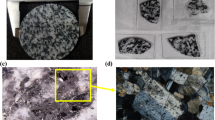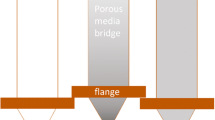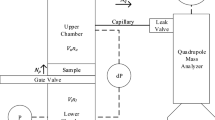Abstract
The gaseous diffusion of neutron activated krypton and xenon were investigated in silicate and sodium chloride media at multiple pressures. Measurements of radionuclide transport were conducted by introducing each gas into the bottom of a 316 stainless steel two- bulb gaseous diffusion apparatus. The porous media bridge between each bulb was filled with either Ottawa density sand or granular sodium chloride sieved to obtain matching particle size distributions. The transport of each radionuclide was monitored by a collimated lanthanum bromide detector at each bulb over the course of several days until equilibrium distribution was achieved. Relative diffusion rates and relaxation times for each nuclide in different media and pressures are discussed and compared to results obtained in prior two-bulb diffusion studies.





Similar content being viewed by others
References
Lowrey JD, Biegalski SR, Osborne AG, Deinert MR (2013) Subsurface mass transport affects the radioxenon signatures that are used to identify clandestine nuclear tests. Geophys Res Lett 40:111–115. https://doi.org/10.1029/2012GL053885
Ringbom A, Elmgren K, Lindh K et al (2009) Measurements of radioxenon in ground level air in South Korea following the claimed nuclear test in North Korea on October 9, 2006. J Radioanal Nucl Chem 282:773–779. https://doi.org/10.1007/s10967-009-0271-8
Robertson JB (1969) Behavior of Xenon-133 Gas after Injection Underground: Molecular Diffusion, Materials Balance, and Barometric Pressure Effects, Report IDO-22051
Olsen KB, Kirkham RR, Woods VT et al (2016) Noble gas migration experiment to support the detection of underground nuclear explosions. J Radioanal Nucl Chem 307:2603–2610. https://doi.org/10.1007/s10967-015-4639-7
Johnson C, Aalseth CE, Alexander TR et al (2019) Migration of noble gas tracers at the site of an underground nuclear explosion at the Nevada National Security Site. J Environ Radioact 208–209. https://doi.org/10.1016/j.jenvrad.2019.106047. :
Ney EP, Armistead FC (1947) The self-diffusion coefficient of uranium hexafluoride. Phys Rev 71:14–19. https://doi.org/10.1103/PhysRev.71.14
Paul MJ, Biegalski SR, Haas DA, Lowrey JD (2018) Adsorptive transport of noble gas tracers in porous media. Int J Mod Phys Conf Ser 48:1860124. https://doi.org/10.1142/s2010194518601242
Byers MF, Paul MJ, Haas DA et al (2018) Evaluation of carbon tetrafluoride as a xenon surrogate for underground gas transport. J Radioanal Nucl Chem 318:465–470. https://doi.org/10.1007/s10967-018-6135-3
Byers MF, Haas DA, Barth BS, Lowrey J (2019) Adsorption of tracer gases in geological media: experimental benchmarking. J Radioanal Nucl Chem 322:1621–1626. https://doi.org/10.1007/s10967-019-06768-3
Gard LM (1963) Nuclear explosions: Some geologic effects of the gnome shot. Sci (80) 139:911–914. https://doi.org/10.1126/science.139.3558.911
U.S. Department of Energy (2018) Salmon, Mississippi, Site Fact Sheet. https://www.energy.gov/sites/prod/files/2019/12/f69/SalmonFactSheet.pdf
Erdoğan ST, Forster AM, Stutzman PE, Garboczi EJ (2017) Particle-based characterization of Ottawa sand: Shape, size, mineralogy, and elastic moduli. Cem Concr Compos 83:36–44. https://doi.org/10.1016/j.cemconcomp.2017.07.003
Wang B, Jin P, Yue Y et al (2015) Synthesis of NaCl single crystals with defined morphologies as templates for fabricating hollow nano/micro-structures. RSC Adv 5:5072–5076. https://doi.org/10.1039/c4ra15385e
Acknowledgements
The authors would like to thank Dr. Brandon De Luna and Bradley Gladden for their assistance in experimental design. This research was funded by the National Nuclear Security Administration, Defense Nuclear Nonproliferation Research and Development (NNSA DNN R&D). The authors acknowledge important interdisciplinary collaboration with scientists and engineers from LANL, LLNL, MSTS, PNNL, and SNL.
Author information
Authors and Affiliations
Corresponding author
Additional information
Publisher’s Note
Springer Nature remains neutral with regard to jurisdictional claims in published maps and institutional affiliations.
Rights and permissions
Springer Nature or its licensor holds exclusive rights to this article under a publishing agreement with the author(s) or other rightsholder(s); author self-archiving of the accepted manuscript version of this article is solely governed by the terms of such publishing agreement and applicable law.
About this article
Cite this article
Lapka, J.L., Haas, D.A. & Lowrey, J.D. Radiokrypton and radioxenon diffusion in silicate and sodium chloride media. J Radioanal Nucl Chem 331, 5161–5166 (2022). https://doi.org/10.1007/s10967-022-08533-5
Received:
Accepted:
Published:
Issue Date:
DOI: https://doi.org/10.1007/s10967-022-08533-5




